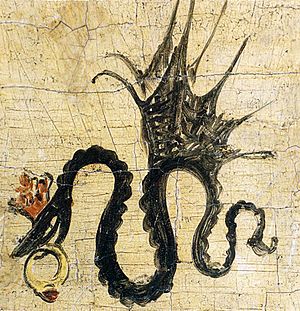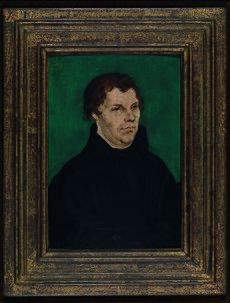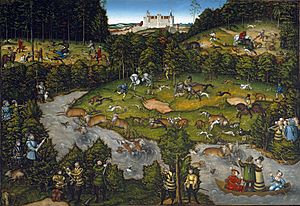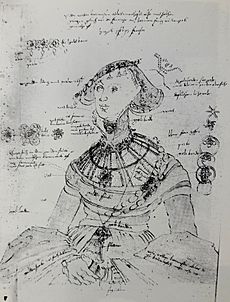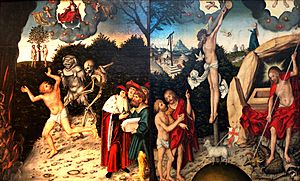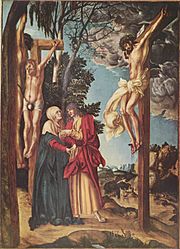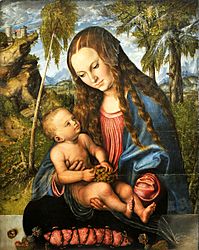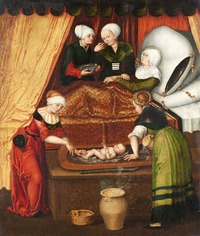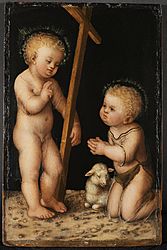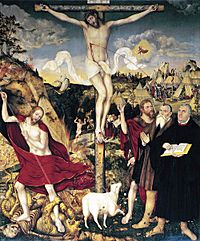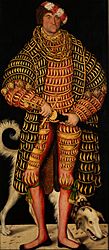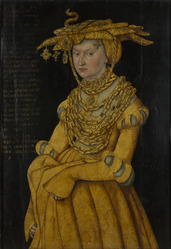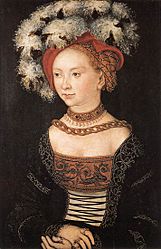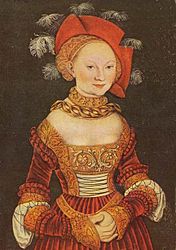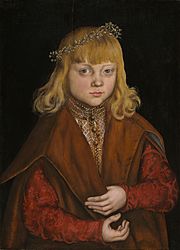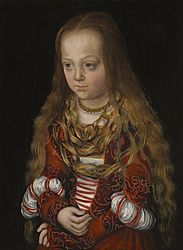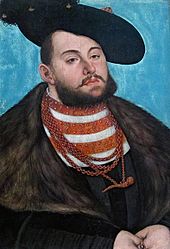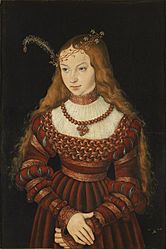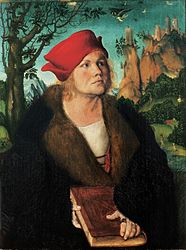Lucas Cranach the Elder facts for kids
Quick facts for kids
Lucas Cranach the Elder
|
|
|---|---|
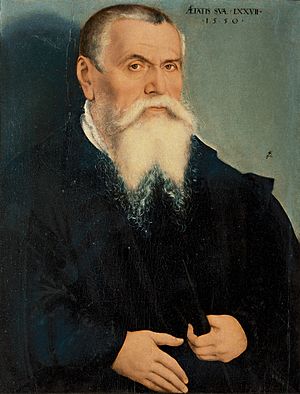
Lucas Cranach the Elder, portrait at age 77, c. 1550, by Lucas Cranach the Younger. Oil on panel, 67 × 49 cm. Uffizi Gallery, Florence
|
|
| Born |
Lucas Maler
c. 1472 |
| Died | 16 October 1553 (aged 80–81) Weimar, Holy Roman Empire
|
| Known for | Painting |
| Movement | German Renaissance |
| Patron(s) | Electors of Saxony |
| Signature | |
 |
|
Lucas Cranach the Elder (German: Lucas Cranach der Ältere c. 1472 – 16 October 1553) was a famous German painter and printmaker. He created art using woodcut and engraving techniques. For most of his life, he was a special artist for the royal court. He is well-known for his portraits of German princes and leaders of the Protestant Reformation. He was also a close friend of Martin Luther, a key figure in the Reformation. Cranach painted many religious scenes, and also subjects from mythology.
Cranach ran a large art workshop. Many of his artworks exist in different versions because his son, Lucas Cranach the Younger, and other artists continued to make copies of his father's works for many years after his death. People consider him one of the most successful German artists of his time.
| Top - 0-9 A B C D E F G H I J K L M N O P Q R S T U V W X Y Z |
Early Life and Family
Lucas Cranach was born in Kronach, a town in central Germany, probably around 1472. We don't know his exact birthday. He learned how to draw from his father, Hans Maler. His father's last name, "Maler," actually meant "painter," showing what he did for a living. Later, Lucas took the name of his hometown, Cranach, as his own last name.
We don't know exactly how Cranach was trained as an artist. He likely learned from local masters in southern Germany. Some people think he spent time in Vienna around the year 1500.
From 1504 to 1520, he lived in a house in Wittenberg.
Becoming a Court Painter
Cranach showed his artistic talent before the 1500s. His work caught the eye of Duke Frederick III, Elector of Saxony, also known as Frederick the Wise. The Duke hired Cranach to work at his court in 1504. Records show that Cranach was paid as the "duke's painter" starting in June 1504. Cranach stayed in the service of the Duke and his family for the rest of his life. However, he was also allowed to take on other art projects.
Cranach married Barbara Brengbier. She was from Gotha, Germany. They had two sons, Hans Cranach and Lucas Cranach the Younger, who both became artists. Hans died in 1537. Lucas the Younger was born in 1515 and continued his father's work. Cranach also had three daughters. One of them, Barbara Cranach, was an ancestor of the famous writer Johann Wolfgang von Goethe.
His Artistic Career
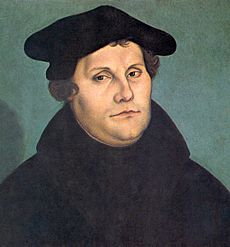
Cranach's first known artwork is from 1504. Early in his career, he worked on many different types of art. He was a decorative painter, but he also created many portraits and altarpieces. He made woodcuts and engravings, and even designed coins for the Duke.
When he first started working for the Duke, Cranach surprised everyone with his realistic paintings of nature. He painted still life, game, and antlers on the walls of country palaces. His paintings of deer and wild boar were very impressive. The Duke even took him hunting to sketch scenes of the hunt.
Before 1508, Cranach painted several altarpieces for the Castle Church in Wittenberg. He was competing with other famous artists like Albrecht Dürer. During this time, he also published some of his best woodcuts and copper-plate prints.
In 1509, Cranach traveled to the Netherlands. There, he painted the Emperor Maximilian and the young boy who would later become Emperor Charles V. Until 1508, Cranach signed his works with his initials. In that year, the Duke gave him a special emblem: a winged snake. After that, Cranach used this winged snake symbol on all his paintings.
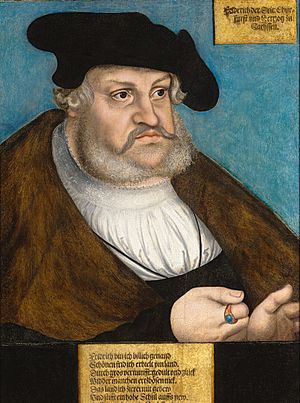
Cranach was the court painter for the Electors of Saxony in Wittenberg from 1505 to 1550. This area was a center for the new Protestant faith. His patrons, the Electors, strongly supported Martin Luther. Cranach used his art to spread the ideas of this new faith. He painted many portraits of Luther and created woodcut pictures for Luther's German translation of the Bible.
The Duke also gave Cranach special rights to sell medicines in Wittenberg. He also got a patent for printing, which meant he had exclusive rights to print Bibles. Cranach's printing presses were used by Martin Luther himself. Cranach's pharmacy shop stayed open for centuries.
Cranach became friends with the Protestant Reformers very early on. It's hard to know exactly when he first met Martin Luther. The oldest mention of Cranach in Luther's letters is from 1520. In a letter from 1521, Luther called Cranach his "gossip," a friendly term for a close friend.
Cranach made an engraving of Luther in 1520. Five years later, Luther left his religious vows, and Cranach was a witness at Luther's engagement to Katharina von Bora. Cranach was also the godfather to their first child, Johannes "Hans" Luther, born in 1526. The Dukes of Saxe-Coburg became big collectors of Cranach's art.
The deaths of Elector Frederick the Wise in 1525 and Elector John in 1532 did not change Cranach's position. He remained a favorite of John Frederick I. Under John Frederick, Cranach even served as the mayor of Wittenberg twice (in 1531 and 1540).
In 1547, John Frederick was captured during the Battle of Mühlberg. Wittenberg was under attack. Cranach wrote to a duke in Königsberg about John Frederick's capture. He showed his loyalty by saying that God would help his prince out of prison.
Three years later, when important leaders met in Augsburg, John Frederick asked Cranach to visit him. Cranach stayed with the captured Elector for a few months. He then went with him back home in 1552.
Death and Legacy
Lucas Cranach the Elder died at age 81 on October 16, 1553, in Weimar. The house where he lived is still there in the marketplace. He was buried in the Jacobsfriedhof cemetery in Weimar.
The Lutheran Church remembers Cranach as an important Christian on April 6, along with other famous artists like Dürer.
Artworks and Style
The oldest painting by Cranach that we still have is Rest of the Virgin during the Flight into Egypt, from 1504. This painting already shows his great skill. The pine forest in the background suggests he knew the mountain scenery of Thuringia well.
Most of Cranach's work consists of portraits. Thanks to him, we know what many German Reformers and their princely supporters looked like. He painted not only Martin Luther but also Luther's wife and parents. He also painted important Catholic figures.
In 1533, Cranach was paid for "sixty pairs of portraits of the elector and his brother" in one day. This shows how much art he produced and that he had a large workshop helping him. Because of this, the quality of his works can vary.
Religious Paintings
Cranach's religious paintings show how the Protestant Reformation developed and how people viewed religious images. Early in his career, he painted many Madonnas (paintings of Mary, the mother of Jesus). His first woodcut in 1505 showed the Virgin and three saints praying before a crucifix. Later, he painted scenes like the marriage of St. Catherine and scenes from the Passion (the story of Jesus's suffering).
After 1517, he still painted traditional religious subjects. However, he also started to express the ideas of the Reformers, though his portraits of reformers were more common than religious scenes.
Towards the end of his life, Cranach painted several "Lutheran altarpieces." These showed Christ in a traditional way, with a halo. But the apostles, without halos, were actually portraits of leading reformers.
One of his last works is an altarpiece for the city church in Weimar. His son, Lucas Cranach the Younger, finished it in 1555 after his father's death. This artwork is very unique. It shows Christ twice: on the left, stepping on Death and Satan, and on the right, crucified. John the Baptist points to the suffering Christ. Blood from Christ's wound falls on a portrait of Cranach himself, while Luther reads from his book, "The blood of Christ cleanseth from all sin."
-
Madonna under the fir tree, 1510, Archdiocesan Museum, Wrocław
-
The Herderkirche Weimar Altarpiece by Lucas Cranach the Elder and finished by his son Lucas Cranach the Younger in 1555 after his father's death.
Mythological Paintings
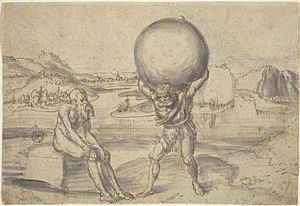
Cranach was also very good at painting scenes from mythology. These paintings often featured slim female figures. He created these mythological works early in his career, and they show influences from Italian art.
Notable Paintings
Portraits
-
Albert of Prussia, 1528, Herzog Anton Ulrich Museum
Religion, Mythology, and Allegory
Looted Artworks
Some of Cranach's paintings were taken from their owners during World War II. For example, his painting "Cupid Complaining to Venus" was part of a collection that was later investigated because it was suspected to have been taken unfairly.
See also
 In Spanish: Lucas Cranach el Viejo para niños
In Spanish: Lucas Cranach el Viejo para niños


